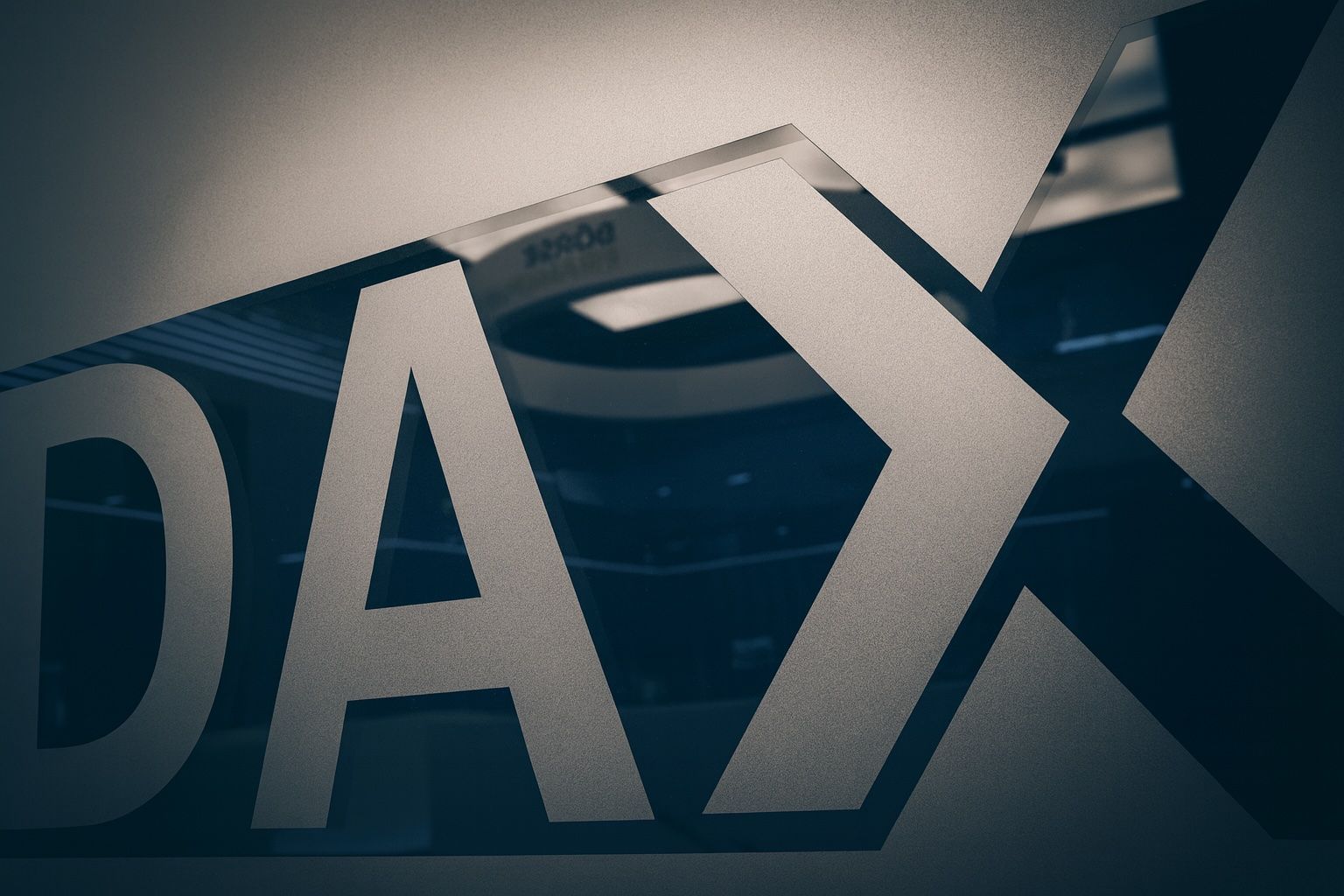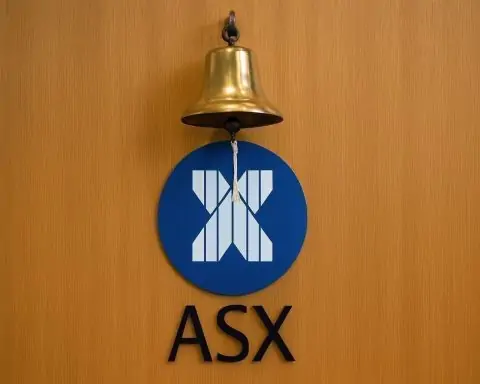FRANKFURT, Germany – The German stock market came under renewed pressure on Tuesday, 18 November 2025, as the DAX slipped to its lowest level since June amid a global risk-off move, profit-taking in recent outperformers and fresh weakness in cyclical shares. Concerns about U.S. interest rates, delayed economic data after the long U.S. government shutdown, and nervousness ahead of Nvidia’s earnings kept buyers on the sidelines. [1]
DAX Today: New Lows for the Autumn Rally
In early Xetra trading, the DAX fell as low as 23,227 points, its weakest level since June. By the end of the first trading hour it had recovered slightly to around 23,287 points, still down about 1.3% on the day. [2]
The decline marked an important technical break: for the first time since April, the index traded below its 200‑day moving average, a widely watched long‑term trend indicator. Market technicians warn that a sustained move beneath this line could end the sideways-to-upwards pattern that has dominated since spring and open the door to a deeper correction. [3]
Other major indices in Frankfurt also lost ground:
- MDAX (mid caps) fell about 1.3% to roughly 28,715 points. [4]
- SDAX (small caps) slid around 1.4%. [5]
- The EuroStoxx 50 benchmark for the eurozone dropped about 1.3% to 5,565 points, moving in lockstep with Germany. [6]
Despite the pullback, the DAX remains up roughly 17% year-to-date, still ahead of the MDAX, EuroStoxx 50 and even the U.S. Dow Jones Industrial Average. [7]
Global Risk-Off Mood and Fed Jitters Weigh on Frankfurt
Tuesday’s selling in Frankfurt is part of a broader global retreat in risk assets:
- European shares were “set to open with steep losses” as investors moved into safe-haven German Bunds, pushing the 10‑year yield down to around 2.70% after touching a six‑week high on Monday. [8]
- A global equity sell-off that began late Monday in the U.S. spilled into Asia and Europe; European indices are now on their fourth straight down day. [9]
- Bitcoin, which hit an all‑time high near $126,000 last month, briefly dropped below $90,000 overnight before bouncing, a sign of fading risk appetite in speculative corners of the market. [10]
For German equities, two catalysts are front and centre:
- U.S. rate expectations
Key U.S. labour market data, delayed by what analysts describe as the longest government shutdown in history, is now due later this week. Until those numbers arrive, markets are flying semi‑blind on the true state of the U.S. economy. Investors worry that the Federal Reserve may slow or pause its rate‑cut path in December, should the data come in too hot. [11] - Nvidia earnings and the AI trade
Tomorrow’s earnings from Nvidia – the poster child of the global AI boom – are seen as a stress test for the entire growth/tech trade. German and European investors are watching closely because AI‑linked stories, from chipmakers to data‑centre power suppliers, have also been key drivers of the DAX this year. [12]
As risk sentiment deteriorates, Bunds and other high‑grade sovereign bonds have attracted fresh demand, while cyclicals and high‑beta stocks across Frankfurt’s trading floor have been sold. [13]
Rheinmetall Shines Against the Trend
One notable bright spot in an otherwise red sea is Rheinmetall. The defence and automotive supplier’s shares climbed around 1.8% in morning trade, briefly moving above €1,800, a four‑week high and a stark contrast to the DAX’s decline. [14]
The move comes as Rheinmetall hosts its Capital Markets Day, where management told investors it expects:
- Revenue to rise to about €50 billion by 2030,
- An operating margin of more than 20% by that date. [15]
With global defence budgets rising in response to geopolitical tensions, Rheinmetall is positioning itself as a long‑term beneficiary, and investors appear willing to look past short‑term volatility in the wider market. [16]
Fraport and Media Stocks Drag the MDAX
In the MDAX, the biggest story of the day is Fraport, the Frankfurt airport operator.
- The stock tumbled as much as 7.7% before trimming losses to around –5%, making it one of the heaviest mid‑cap losers. [17]
- Goldman Sachs downgraded Fraport from Buy to Neutral and cut its price target to €86, arguing that the share price has run ahead of fundamentals after strong gains and warning about the risk of rising capital expenditures. [18]
The downgrade comes at a delicate time: investors have been rotating out of interest‑rate‑sensitive and capital‑intensive infrastructure names as bond yields rose earlier in the month, and Tuesday’s move suggests many see limited upside left for Fraport at current valuations.
Another pressure point in the MDAX is RTL Group, whose shares dropped around 4% after the broadcaster lowered its full‑year outlook. The company cited persistent weakness in TV advertising, with third‑quarter revenue coming in slightly below analyst expectations. [19]
Together, the Fraport and RTL moves highlight how consumer‑facing and media businesses remain vulnerable to a slowing economy and shifting advertising and travel patterns. [20]
DAX Movers: Banks, Industrials and AI Beneficiaries Under Pressure
Within the DAX, most heavyweights traded lower in early dealings.
Financials and cyclicals
- Deutsche Bank fell roughly 3% to around €29.8, ranking among the weakest index members despite a supportive analyst note. JPMorgan reiterated an Overweight rating on Tuesday with a €38.40 price target, praising the “enormous turnaround” under current management and calling the bank’s growth and return‑on‑equity goals ambitious yet achievable. [21]
- Daimler Truck slipped close to 3% to just under €34, extending losses after reports of a recall of nearly 19,000 trucks in the U.S. and concerns about the cost impact. Trading data from Xetra showed the stock down about 2.6–3% across German venues late in the morning. [22]
Growth and AI‑related stories
- Siemens Energy, which has been on a remarkable rally this year, was another notable loser, sliding just under 3% intraday. [23]
- The stock had only yesterday set a fresh record high near €114.60 on the back of strong quarterly numbers and a wave of analyst upgrades, including price targets raised to €130–135 by Deutsche Bank and Santander. Over the past 12 months, Siemens Energy has gained more than 130%, vastly outperforming the DAX. [24]
- Tuesday’s pullback therefore looks largely like profit‑taking in a high‑flyer rather than a reassessment of the fundamental story around energy infrastructure and data‑centre power demand. [25]
E‑commerce and consumer
- Zalando continued to struggle near multi‑month lows. After setting a new 12‑month low at €22.11 on Monday, the stock traded around €21.7–22.3 today, roughly 2% lower at times, as investors remain cautious on European online retail and fashion spending. [26]
Relative Safe Havens: Deutsche Börse, Utilities and Telecoms
Not all DAX names suffered equally.
According to intraday data from Frankfurt:
- Deutsche Börse shares were roughly flat to slightly higher around €203–204, making them one of the day’s best index constituents. [27]
- Deutsche Telekom, E.ON and QIAGEN also outperformed the broader market, with losses of less than 0.5%, reflecting renewed investor demand for defensive, cash‑generative sectors such as telecoms, utilities and healthcare. [28]
Deutsche Börse also had its own news catalyst: the exchange operator announced it will integrate Societe Generale’s dollar‑ and euro‑backed stablecoins into Clearstream, its settlement and custody arm. The partnership is intended to make these tokens usable for settlement and collateral management and marks their first integration into a major traditional financial platform. [29]
The move underlines how Frankfurt is quietly becoming a testing ground for institutional‑grade crypto infrastructure, even as crypto prices themselves experience sharp swings.
Small Caps and SDAX: Verve Group and SFC Energy Hit Hard
Volatility was even more pronounced further down the market‑cap scale.
In the SDAX, two names stood out on the downside: [30]
- Verve Group (digital advertising and gaming) plunged more than 20% at the worst point before recovering somewhat. The company is still struggling with technical problems during a platform migration, and updated guidance for 2025 is complicated by changes in revenue recognition, making comparisons difficult. [31]
- SFC Energy, a fuel‑cell specialist, fell almost 11% after warning that delays in defence‑related orders and increased market uncertainty mean full‑year revenue will likely land at the lower end of its previous range. [32]
These sharp moves illustrate how idiosyncratic news and guidance changes can drive double‑digit percentage swings in small caps, especially when overall risk appetite is low.
Macro Backdrop: Cautious Optimism, Structural Concerns
Beyond the day’s price action, the macro environment for Germany remains mixed.
- The ZEW Economic Sentiment Index for Germany slipped unexpectedly in November to 38.5 from 39.3, missing consensus expectations of 41. Although the reading remains clearly positive – indicating that most financial market experts still expect conditions to improve over the coming six months – ZEW highlighted falling confidence in the government’s ability to tackle structural challenges. [33]
- The European Commission’s autumn forecast projects only 0.2% GDP growth for Germany in 2025, with a somewhat stronger 1.2% expansion in 2026, slightly below the average for the euro area. [34]
At the same time, the ECB and Bundesbank are increasingly vocal about financial‑stability risks. ECB Vice‑President Luis de Guindos warned that negative economic shocks could trigger higher corporate insolvencies and valuation corrections in non‑bank financial institutions, while the Bundesbank notes a steady rise in non‑performing loans since late 2022. [35]
These warnings form the backdrop to today’s market moves: investors are reassessing credit risk, leverage and stretched valuations after a strong year for equities.
Technical Picture: DAX at a Crossroads
From a chart perspective, market strategists describe the DAX as being at a critical juncture: [36]
- The index is testing support in the 23,200–23,300 zone, which roughly corresponds to recent swing lows and the now‑broken 200‑day moving average.
- Key resistance is seen back near 24,000 points, with the October record high around 24,771 forming the upper boundary of the current range. [37]
Analysts at several brokerages argue that if global risk sentiment stabilises and U.S. data do not significantly alter Fed expectations, the DAX could resume its year‑end rally. But a deeper correction remains possible if bond yields spike again or if Nvidia’s earnings disappoint and trigger a broader unwind in AI‑linked trades. [38]
What German Equity Investors Should Watch Next
Looking ahead to the rest of the week, German stock market participants will be focused on several key events:
- Nvidia earnings (Wednesday night, European time)
The results and guidance of the U.S. chip giant are likely to influence risk appetite for tech and growth stocks globally, including European suppliers and infrastructure plays. [39] - U.S. macro data (later this week)
Delayed labour‑market and inflation releases will help clarify whether the Fed can continue easing policy into 2026, a crucial driver for global equities and the euro‑dollar exchange rate. [40] - Eurozone inflation data
The EU statistics office is scheduled to release October HICP inflation figures today, giving investors fresh insight into the trajectory of euro‑area prices and the ECB’s next steps. [41] - Further company events and guidance updates
After Rheinmetall’s Capital Markets Day, markets will watch whether other DAX and MDAX constituents adjust their 2025–2030 ambitions in response to the changing macro backdrop. [42]
Bottom Line: A Healthy Correction or Something More?
For now, Tuesday’s session in Frankfurt looks like a broad but orderly correction after a strong year for German equities, rather than outright panic:
- The DAX remains comfortably positive year‑to‑date,
- Defensive stocks and quality earnings stories are still attracting capital,
- But cyclicals, rate‑sensitive names and richly valued growth plays are seeing sharper pullbacks. [43]
Whether the recent drop proves to be a buy‑the‑dip opportunity or the start of a more protracted downturn will depend largely on incoming U.S. data, Fed communication and whether corporate earnings – starting with Nvidia – can justify the valuations investors have been willing to pay in 2025.
As always, this article is for information purposes only and does not constitute investment advice. Anyone considering investing in German or other equities should assess their own financial situation and risk tolerance, and seek professional advice where appropriate.
References
1. de.investing.com, 2. de.investing.com, 3. de.investing.com, 4. de.investing.com, 5. de.investing.com, 6. de.investing.com, 7. de.investing.com, 8. m.economictimes.com, 9. www.bloomberg.com, 10. www.bloomberg.com, 11. de.investing.com, 12. de.investing.com, 13. m.economictimes.com, 14. de.investing.com, 15. www.finanzen.ch, 16. www.finanznachrichten.de, 17. de.investing.com, 18. www.wallstreet-online.de, 19. de.investing.com, 20. www.4investors.de, 21. www.finanzen.net, 22. www.aktiencheck.de, 23. www.finanzen.net, 24. www.focus.de, 25. www.focus.de, 26. www.boerse.de, 27. www.finanzen.net, 28. www.finanzen.net, 29. www.reuters.com, 30. de.investing.com, 31. de.investing.com, 32. de.investing.com, 33. www.reuters.com, 34. www.merkur.de, 35. www.4investors.de, 36. www.xtb.com, 37. www.investing.com, 38. www.bloomberg.com, 39. de.investing.com, 40. m.economictimes.com, 41. ec.europa.eu, 42. www.finanzen.ch, 43. de.investing.com









